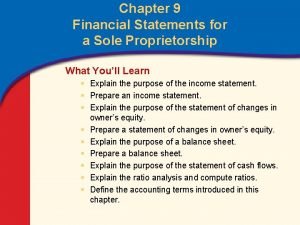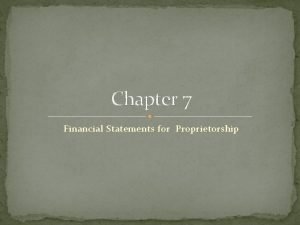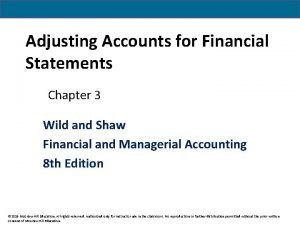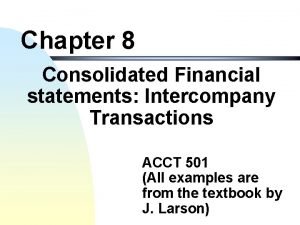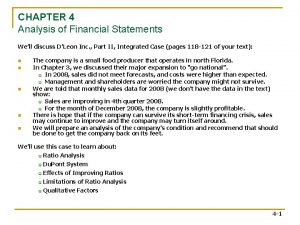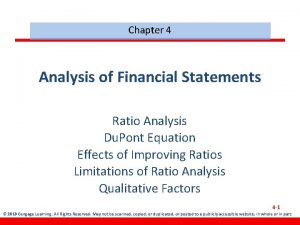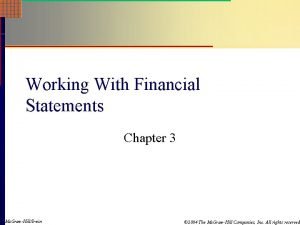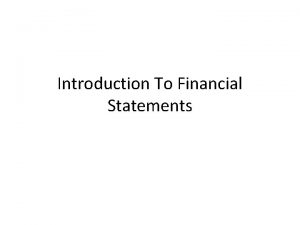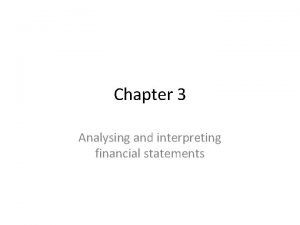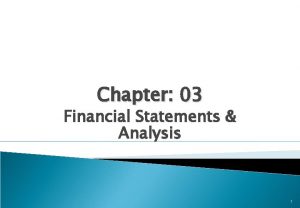Chapter 13 Interpreting Financial Statements C 1C 2










- Slides: 10

Chapter 13 Interpreting Financial Statements

C 1/C 2 Building Blocks of Analysis Ability to meet short-term obligations and to efficiently generate revenues Ability to provide financial rewards sufficient to attract and retain financing Liquidity and Efficiency Solvency Market Profitability Prospects Ability to generate future revenues and meet long-term obligations Ability to generate positive market expectations 13 -2

Ratio Analysis p. 573 of text book

P 3 Liquidity and Efficiency - ability to pay ST obligations & Generate revenues Inventory Turnover Current Ratio Days’ Sales Uncollected Acid-test Ratio Accounts Receivable Turnover Days’ Sales in Inventory Total Asset Turnover 13 -4

P 3 Solvency - ability to generate future revenues & meet LT obligations Debt Ratio Equity Ratio Pledged Assets to Secured Liabilities Times Interest Earned 13 -5

P 3 Profitability - ability to provide financial rewards sufficient to attract & retain financing. Profit Margin Basic Earnings per Share Gross Margin Return on Total Assets Book Value per Common Share Return on Common Stockholders’ Equity 13 -6

P 3 Market Prospects Price/Earnings (PE) ratio Dividend Yield Ability to generate positive market expectations and interest in the company’s stock. 13 -7

CLOVER CORPORATION Comparative Income Statements For the Years Ended December 31, 2015 Common-size Percents* 2015 2014 Revenues $ 520, 000 $ 480, 000 100. 0% Costs and expenses: Cost of sales 360, 000 315, 000 69. 2% 65. 6% Selling and admin. 128, 600 126, 000 24. 7% 26. 3% Interest expense 6, 400 7, 000 1. 2% 1. 5% Income before taxes $ 25, 000 $ 32, 000 4. 8% 6. 7% Income taxes (30%) 7, 500 9, 600 1. 4% 2. 0% Net income $ 17, 500 $ 22, 400 3. 4% 4. 7% Net income per share $ 0. 79 $ 1. 01 Avg. # common shares 22, 200 * Rounded to first decimal point. P 2 13 -8

P 2 Common-Size Graphics This is a graphical analysis of Clover Corporation’s common-size income statement for 2015. 13 -9

C 3 Standards for Comparison When interpreting measures, we need to decide whether the measures indicate good, bad, or average performance. We can use the following to make that judgment: n Intracompany n Competitor n Industry n Guidelines (rule of thumb) 13 -10
 Chapter 3 analysis of financial statements
Chapter 3 analysis of financial statements Adjusting accounts for financial statements chapter 3
Adjusting accounts for financial statements chapter 3 Sole proprietorship income statement
Sole proprietorship income statement Chapter 7 financial statements for a proprietorship
Chapter 7 financial statements for a proprietorship Adjusting accounts for financial statements
Adjusting accounts for financial statements Intercompany bond transactions
Intercompany bond transactions Chapter 4 analysis of financial statements
Chapter 4 analysis of financial statements Chapter 4 analysis of financial statements
Chapter 4 analysis of financial statements Financial statements and ratio analysis chapter 3
Financial statements and ratio analysis chapter 3 Chapter 2 financial statements taxes and cash flow
Chapter 2 financial statements taxes and cash flow Working with financial statements chapter 3
Working with financial statements chapter 3


